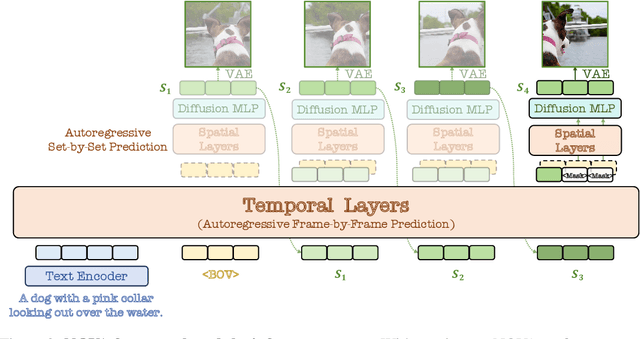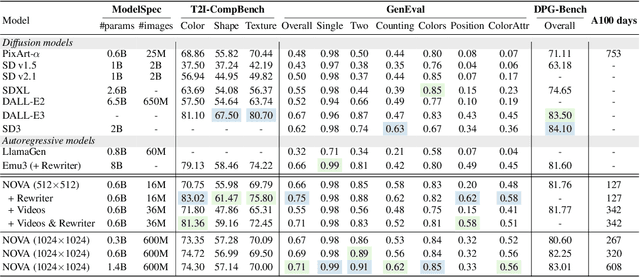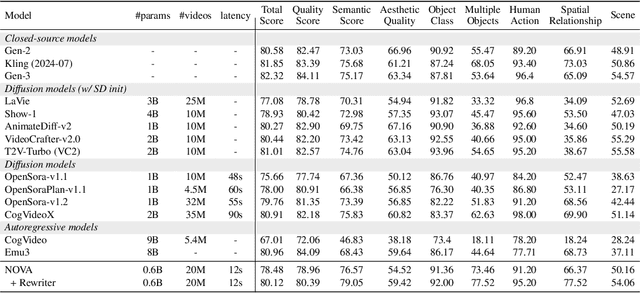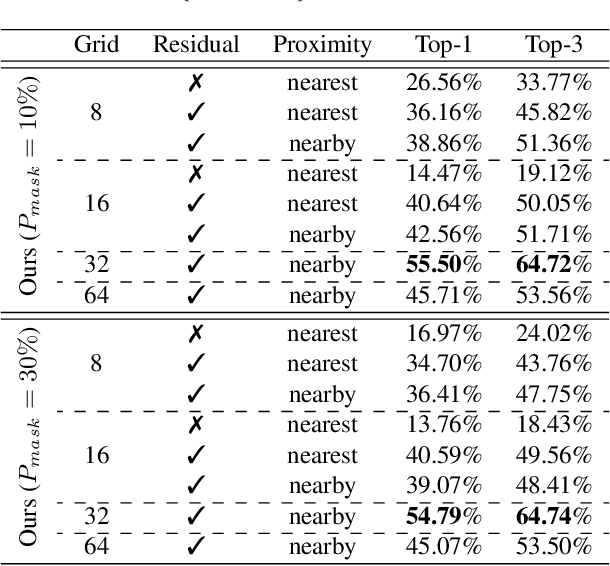Yonggang Qi
FantasyPortrait: Enhancing Multi-Character Portrait Animation with Expression-Augmented Diffusion Transformers
Jul 17, 2025Abstract:Producing expressive facial animations from static images is a challenging task. Prior methods relying on explicit geometric priors (e.g., facial landmarks or 3DMM) often suffer from artifacts in cross reenactment and struggle to capture subtle emotions. Furthermore, existing approaches lack support for multi-character animation, as driving features from different individuals frequently interfere with one another, complicating the task. To address these challenges, we propose FantasyPortrait, a diffusion transformer based framework capable of generating high-fidelity and emotion-rich animations for both single- and multi-character scenarios. Our method introduces an expression-augmented learning strategy that utilizes implicit representations to capture identity-agnostic facial dynamics, enhancing the model's ability to render fine-grained emotions. For multi-character control, we design a masked cross-attention mechanism that ensures independent yet coordinated expression generation, effectively preventing feature interference. To advance research in this area, we propose the Multi-Expr dataset and ExprBench, which are specifically designed datasets and benchmarks for training and evaluating multi-character portrait animations. Extensive experiments demonstrate that FantasyPortrait significantly outperforms state-of-the-art methods in both quantitative metrics and qualitative evaluations, excelling particularly in challenging cross reenactment and multi-character contexts. Our project page is https://fantasy-amap.github.io/fantasy-portrait/.
FantasyTalking: Realistic Talking Portrait Generation via Coherent Motion Synthesis
Apr 07, 2025Abstract:Creating a realistic animatable avatar from a single static portrait remains challenging. Existing approaches often struggle to capture subtle facial expressions, the associated global body movements, and the dynamic background. To address these limitations, we propose a novel framework that leverages a pretrained video diffusion transformer model to generate high-fidelity, coherent talking portraits with controllable motion dynamics. At the core of our work is a dual-stage audio-visual alignment strategy. In the first stage, we employ a clip-level training scheme to establish coherent global motion by aligning audio-driven dynamics across the entire scene, including the reference portrait, contextual objects, and background. In the second stage, we refine lip movements at the frame level using a lip-tracing mask, ensuring precise synchronization with audio signals. To preserve identity without compromising motion flexibility, we replace the commonly used reference network with a facial-focused cross-attention module that effectively maintains facial consistency throughout the video. Furthermore, we integrate a motion intensity modulation module that explicitly controls expression and body motion intensity, enabling controllable manipulation of portrait movements beyond mere lip motion. Extensive experimental results show that our proposed approach achieves higher quality with better realism, coherence, motion intensity, and identity preservation. Ours project page: https://fantasy-amap.github.io/fantasy-talking/.
FantasyID: Face Knowledge Enhanced ID-Preserving Video Generation
Feb 19, 2025



Abstract:Tuning-free approaches adapting large-scale pre-trained video diffusion models for identity-preserving text-to-video generation (IPT2V) have gained popularity recently due to their efficacy and scalability. However, significant challenges remain to achieve satisfied facial dynamics while keeping the identity unchanged. In this work, we present a novel tuning-free IPT2V framework by enhancing face knowledge of the pre-trained video model built on diffusion transformers (DiT), dubbed FantasyID. Essentially, 3D facial geometry prior is incorporated to ensure plausible facial structures during video synthesis. To prevent the model from learning copy-paste shortcuts that simply replicate reference face across frames, a multi-view face augmentation strategy is devised to capture diverse 2D facial appearance features, hence increasing the dynamics over the facial expressions and head poses. Additionally, after blending the 2D and 3D features as guidance, instead of naively employing cross-attention to inject guidance cues into DiT layers, a learnable layer-aware adaptive mechanism is employed to selectively inject the fused features into each individual DiT layers, facilitating balanced modeling of identity preservation and motion dynamics. Experimental results validate our model's superiority over the current tuning-free IPT2V methods.
Autoregressive Video Generation without Vector Quantization
Dec 18, 2024



Abstract:This paper presents a novel approach that enables autoregressive video generation with high efficiency. We propose to reformulate the video generation problem as a non-quantized autoregressive modeling of temporal frame-by-frame prediction and spatial set-by-set prediction. Unlike raster-scan prediction in prior autoregressive models or joint distribution modeling of fixed-length tokens in diffusion models, our approach maintains the causal property of GPT-style models for flexible in-context capabilities, while leveraging bidirectional modeling within individual frames for efficiency. With the proposed approach, we train a novel video autoregressive model without vector quantization, termed NOVA. Our results demonstrate that NOVA surpasses prior autoregressive video models in data efficiency, inference speed, visual fidelity, and video fluency, even with a much smaller model capacity, i.e., 0.6B parameters. NOVA also outperforms state-of-the-art image diffusion models in text-to-image generation tasks, with a significantly lower training cost. Additionally, NOVA generalizes well across extended video durations and enables diverse zero-shot applications in one unified model. Code and models are publicly available at https://github.com/baaivision/NOVA.
VersaGen: Unleashing Versatile Visual Control for Text-to-Image Synthesis
Dec 17, 2024



Abstract:Despite the rapid advancements in text-to-image (T2I) synthesis, enabling precise visual control remains a significant challenge. Existing works attempted to incorporate multi-facet controls (text and sketch), aiming to enhance the creative control over generated images. However, our pilot study reveals that the expressive power of humans far surpasses the capabilities of current methods. Users desire a more versatile approach that can accommodate their diverse creative intents, ranging from controlling individual subjects to manipulating the entire scene composition. We present VersaGen, a generative AI agent that enables versatile visual control in T2I synthesis. VersaGen admits four types of visual controls: i) single visual subject; ii) multiple visual subjects; iii) scene background; iv) any combination of the three above or merely no control at all. We train an adaptor upon a frozen T2I model to accommodate the visual information into the text-dominated diffusion process. We introduce three optimization strategies during the inference phase of VersaGen to improve generation results and enhance user experience. Comprehensive experiments on COCO and Sketchy validate the effectiveness and flexibility of VersaGen, as evidenced by both qualitative and quantitative results.
SAUGE: Taming SAM for Uncertainty-Aligned Multi-Granularity Edge Detection
Dec 17, 2024Abstract:Edge labels are typically at various granularity levels owing to the varying preferences of annotators, thus handling the subjectivity of per-pixel labels has been a focal point for edge detection. Previous methods often employ a simple voting strategy to diminish such label uncertainty or impose a strong assumption of labels with a pre-defined distribution, e.g., Gaussian. In this work, we unveil that the segment anything model (SAM) provides strong prior knowledge to model the uncertainty in edge labels. Our key insight is that the intermediate SAM features inherently correspond to object edges at various granularities, which reflects different edge options due to uncertainty. Therefore, we attempt to align uncertainty with granularity by regressing intermediate SAM features from different layers to object edges at multi-granularity levels. In doing so, the model can fully and explicitly explore diverse ``uncertainties'' in a data-driven fashion. Specifically, we inject a lightweight module (~ 1.5% additional parameters) into the frozen SAM to progressively fuse and adapt its intermediate features to estimate edges from coarse to fine. It is crucial to normalize the granularity level of human edge labels to match their innate uncertainty. For this, we simply perform linear blending to the real edge labels at hand to create pseudo labels with varying granularities. Consequently, our uncertainty-aligned edge detector can flexibly produce edges at any desired granularity (including an optimal one). Thanks to SAM, our model uniquely demonstrates strong generalizability for cross-dataset edge detection. Extensive experimental results on BSDS500, Muticue and NYUDv2 validate our model's superiority.
Symmetrical Joint Learning Support-query Prototypes for Few-shot Segmentation
Jul 27, 2024



Abstract:We propose Sym-Net, a novel framework for Few-Shot Segmentation (FSS) that addresses the critical issue of intra-class variation by jointly learning both query and support prototypes in a symmetrical manner. Unlike previous methods that generate query prototypes solely by matching query features to support prototypes, which is a form of bias learning towards the few-shot support samples, Sym-Net leverages a balanced symmetrical learning approach for both query and support prototypes, ensuring that the learning process does not favor one set (support or query) over the other. One of main modules of Sym-Net is the visual-text alignment-based prototype aggregation module, which is not just query-guided prototype refinement, it is a jointly learning from both support and query samples, which makes the model beneficial for handling intra-class discrepancies and allows it to generalize better to new, unseen classes. Specifically, a parameter-free prior mask generation module is designed to accurately localize both local and global regions of the query object by using sliding windows of different sizes and a self-activation kernel to suppress incorrect background matches. Additionally, to address the information loss caused by spatial pooling during prototype learning, a top-down hyper-correlation module is integrated to capture multi-scale spatial relationships between support and query images. This approach is further jointly optimized by implementing a co-optimized hard triplet mining strategy. Experimental results show that the proposed Sym-Net outperforms state-of-the-art models, which demonstrates that jointly learning support-query prototypes in a symmetrical manner for FSS offers a promising direction to enhance segmentation performance with limited annotated data.
DiffSketching: Sketch Control Image Synthesis with Diffusion Models
May 30, 2023



Abstract:Creative sketch is a universal way of visual expression, but translating images from an abstract sketch is very challenging. Traditionally, creating a deep learning model for sketch-to-image synthesis needs to overcome the distorted input sketch without visual details, and requires to collect large-scale sketch-image datasets. We first study this task by using diffusion models. Our model matches sketches through the cross domain constraints, and uses a classifier to guide the image synthesis more accurately. Extensive experiments confirmed that our method can not only be faithful to user's input sketches, but also maintain the diversity and imagination of synthetic image results. Our model can beat GAN-based method in terms of generation quality and human evaluation, and does not rely on massive sketch-image datasets. Additionally, we present applications of our method in image editing and interpolation.
Zero-Shot Everything Sketch-Based Image Retrieval, and in Explainable Style
Mar 25, 2023



Abstract:This paper studies the problem of zero-short sketch-based image retrieval (ZS-SBIR), however with two significant differentiators to prior art (i) we tackle all variants (inter-category, intra-category, and cross datasets) of ZS-SBIR with just one network (``everything''), and (ii) we would really like to understand how this sketch-photo matching operates (``explainable''). Our key innovation lies with the realization that such a cross-modal matching problem could be reduced to comparisons of groups of key local patches -- akin to the seasoned ``bag-of-words'' paradigm. Just with this change, we are able to achieve both of the aforementioned goals, with the added benefit of no longer requiring external semantic knowledge. Technically, ours is a transformer-based cross-modal network, with three novel components (i) a self-attention module with a learnable tokenizer to produce visual tokens that correspond to the most informative local regions, (ii) a cross-attention module to compute local correspondences between the visual tokens across two modalities, and finally (iii) a kernel-based relation network to assemble local putative matches and produce an overall similarity metric for a sketch-photo pair. Experiments show ours indeed delivers superior performances across all ZS-SBIR settings. The all important explainable goal is elegantly achieved by visualizing cross-modal token correspondences, and for the first time, via sketch to photo synthesis by universal replacement of all matched photo patches. Code and model are available at \url{https://github.com/buptLinfy/ZSE-SBIR}.
SketchLattice: Latticed Representation for Sketch Manipulation
Aug 26, 2021



Abstract:The key challenge in designing a sketch representation lies with handling the abstract and iconic nature of sketches. Existing work predominantly utilizes either, (i) a pixelative format that treats sketches as natural images employing off-the-shelf CNN-based networks, or (ii) an elaborately designed vector format that leverages the structural information of drawing orders using sequential RNN-based methods. While the pixelative format lacks intuitive exploitation of structural cues, sketches in vector format are absent in most cases limiting their practical usage. Hence, in this paper, we propose a lattice structured sketch representation that not only removes the bottleneck of requiring vector data but also preserves the structural cues that vector data provides. Essentially, sketch lattice is a set of points sampled from the pixelative format of the sketch using a lattice graph. We show that our lattice structure is particularly amenable to structural changes that largely benefits sketch abstraction modeling for generation tasks. Our lattice representation could be effectively encoded using a graph model, that uses significantly fewer model parameters (13.5 times lesser) than existing state-of-the-art. Extensive experiments demonstrate the effectiveness of sketch lattice for sketch manipulation, including sketch healing and image-to-sketch synthesis.
 Add to Chrome
Add to Chrome Add to Firefox
Add to Firefox Add to Edge
Add to Edge